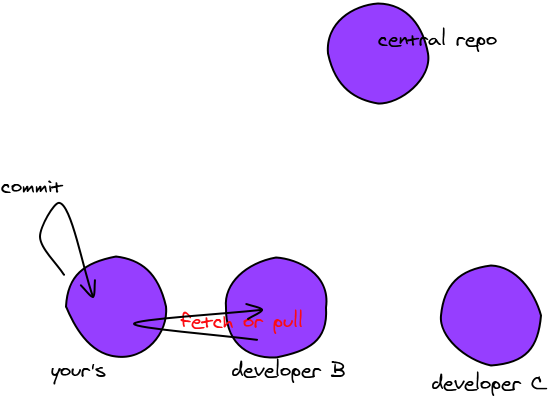What cool things can you do with GIT ?
A “Distributed Version Control System” (DVCS) has so many fascinating things to offer. And it’s no wonder the world is moving towards this fascination.
Of the so many possibilities a DVCS has to offer, there are two that I like a lot.
Read on, to see what…
1 ) Make reusable project skeletons:
I have a project, that I push to a repository. Then I make some changes. Now the new changes, I can push them to a new repository (instead of affecting the old one )
What’s so cool about it ? See this –
As a part of the initial project setup I add junit and dbunit libraries, say… Then push the changes to a repository. Then I make some changes, to make it a hibernate project. Instead of pushing it to the old repository, I push these to a new repository, as shown below
What this lets me do is, create different junit+dbunit projects by cloning the test-skeleton project !
Like this –
There are a lot many times, when I have wanted to try-out some code, but being too lazy to configure , I give up.
Now with project skeletons created, I can reuse them, and fork them to different shapes 😉
And what’s the best part ? If at any time I make changes to test-skeleton,( say I add logging-api) I can pull those changes to any of the projects I had cloned and modified !
2) You don’t have to push to central repo, to share your partial changes !
Normally with a centralized repo, this is how we share our changes :
And likewise in a DVCS (say git )
Say I have written some code. It’s not completely tested though. Developer-B needs this, for his work to start. The rest of the world does not need it immediately ! So how can I share it to developer-B and not to developer-C,D,…Z ?
It’s just as simple as this :
developer-B configures your repository as a remote-repository and pulls changes !
With a command that looks like this (For windows)
git pull \\<your-ip>\shared_directory\<your-repo>Well, that’s it, in this post. The more you explore git, the more you realize of its power ! Join the exploration 😉






nice post that gives an introduction to git and trigger to learn it
sivaram
May 14, 2011 at 9:16 am
Thanks Sivaram 🙂
Vishwanath Krishnamurthi
May 15, 2011 at 12:39 am
Great Vishwa. Keep up the good work. Though I’m not using GIT at the moment, this would be a good tutorial in future. I will bug you then as well.. 😀
Ashoksundar Umayarpatham
June 22, 2011 at 4:06 am
Sure do that 🙂 Almost every little hack project you do, you can push it to http://www.github.com using git. That way you never lose anything.. 😉
Vishwanath Krishnamurthi
June 22, 2011 at 11:00 am
“If at any time I make changes to test-skeleton,( say I add logging-api) I can pull those changes to any of the projects I had cloned and modified”
I am a Git “noob.”
How would I go about doing something like this?
Jeremy
June 29, 2011 at 7:06 pm
Hi Jeremy,
Say I have cloned test-skeleton project, in a directory “concreteOne” with this command –
git clone remote-url-of-testSkeleton
When the cloning is completed,
git remote -v
would list the remote repo associated with this.
It would look something like
origin remote-url-of-testSkeleton (fetch)
origin remote-url-of-testSkeleton (push)
That means that I can fetch/push.
The cool thing is that I can add more remotes,
git remote add aShortName a-different-remote-url
(I’ll create one with a shortname ‘cname’ )
Now when we list the remotes using “git remote -v” it would look something like,
origin remote-url-of-testSkeleton (fetch)
origin remote-url-of-testSkeleton (push)
corigin a-different-remote-url (fetch)
corigin a-different-remote-url (push)
This means that I can fetch or pull from any of these listed remotes.
I can now change the cloned project to something concrete (say hibernate project ) and push it to corigin instead of origin
git push corigin master
If testSkeleton project has had some changes, I can take it here by,
git pull origin
In short, its all because of the ability to “add multiple remotes easily”
Vishwanath Krishnamurthi
July 1, 2011 at 12:10 pm